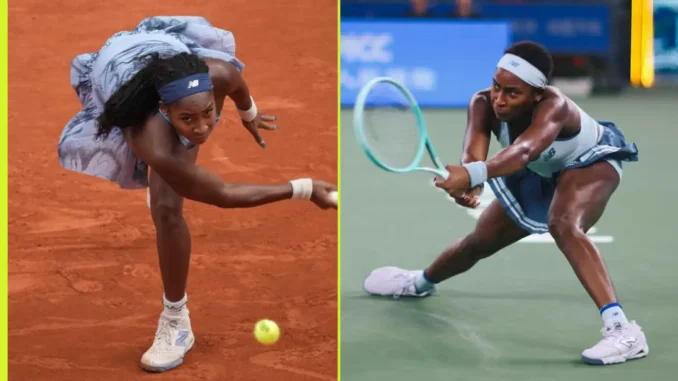
In the dynamic world of professional tennis, where surfaces shift the rhythm of play and test a player’s adaptability, Coco Gauff stands as a beacon of versatility and raw talent. At just 21, the American phenom has carved out a reputation as one of the WTA’s brightest stars, her explosive athleticism and relentless drive captivating fans globally. As she prepares for the 2025 Aux Ningbo Open, a WTA 500 event on the hard courts of China’s Yinzhou Tennis Center from October 13-19, the question looms: where does Gauff truly shine? Is it the unforgiving bounce of hard courts, where her speed and power collide, or the gritty slide of red clay, where her patience and tactical nous are put to the test? The answer, woven through her career’s highs and lows, reveals a player whose brilliance transcends surfaces but finds its sharpest edge on one.
Gauff’s journey began on the hard courts of Florida, where she honed her game under the relentless sun. Her breakout moment came at 15, stunning Venus Williams at Wimbledon 2019, but it was on hard courts that she first announced her dominance. The 2023 US Open remains her crowning achievement, where, as a teenager, she clinched her maiden Grand Slam title, defeating Aryna Sabalenka in a thrilling final, 2-6, 6-3, 6-2. That victory, in front of a roaring New York crowd, cemented her hard-court credentials. She followed it with a monumental triumph at the 2023 China Open, becoming the youngest WTA 1000 champion since 2004 by outlasting Elena Rybakina in a 6-4, 3-6, 6-4 epic. These wins, coupled with titles in Washington, D.C., and Cincinnati, showcase a player tailor-made for the surface’s fast pace. “I grew up on hard courts; it’s where I feel free to just go for it,” Gauff once said, her words reflecting a comfort that translates into blistering serves and ferocious baseline rallies. Her 2025 season, with a 41-18 record and $3.2 million in earnings, includes hard-court highlights like a Dubai semifinal and a Miami quarterfinal, where her 87% first-serve win rate against top-20 opponents speaks to her command.
Yet, red clay holds a special place in Gauff’s story, revealing a different facet of her game. The slower, grittier surface demands patience, spin-heavy shots, and strategic point construction—qualities Gauff has mastered with remarkable poise for her age. Her 2024 Roland Garros campaign was a testament to this, as she claimed her first clay-court Grand Slam title, defeating Iga Swiatek in a stunning 6-4, 7-5 upset to become the youngest French Open women’s champion since 2007. That run wasn’t her first clay success; in 2021, at 17, she reached the Roland Garros quarterfinals, and in 2022, she made the final, falling to Swiatek but proving her mettle. Her 2023 Parma title on clay further underscores her adaptability, with a 70% win rate in clay matches that year. “Clay teaches you to think, to build points like a puzzle,” Gauff reflected after her Paris triumph, highlighting how the surface sharpens her tactical edge. Her topspin-heavy forehand, averaging 2,800 RPMs, and sliding defensive prowess make her a nightmare on the dirt.
Comparing the numbers paints a clearer picture. On hard courts, Gauff boasts a career win rate of 68% across 220 matches, with four of her eight WTA titles, including her biggest paydays. Her aggressive style—clocking serves at 120 mph and winners at a 1.4-per-game clip—thrives on the consistent bounce. Clay, however, sees a slightly lower 65% win rate over 85 matches, but her 2024 Roland Garros title and 2022 final tilt the scales. Advanced metrics from 2025 show her hard-court return game is elite, breaking opponents 42% of the time, while clay rewards her defensive consistency, with 55% of points won on second serves. Injuries, like a 2025 ankle tweak that forced a Stuttgart withdrawal, have occasionally disrupted her clay season, but her 12-3 clay record in 2024 outshines her 28-12 hard-court mark for efficiency.
The Ningbo Open, with its $1.06 million purse and 28-player draw, offers a fresh stage for Gauff to flex her hard-court prowess. As a top seed, she faces qualifiers or wildcards early, but the field—bristling with Elena Rybakina, Jasmine Paolini, and Jelena Ostapenko—demands focus. A potential quarterfinal against Barbora Krejcikova or a semifinal with Mirra Andreeva looms as a test. Off the court, Gauff’s cultural impact grows; her advocacy for mental health and recent Vogue feature amplify her voice. “Every surface brings out something new in me,” she said in Ningbo, a nod to her evolution.
So, what’s Gauff’s best surface? Hard courts edge out, fueled by her upbringing, title count, and statistical dominance. Her US Open and China Open triumphs, paired with her explosive style, make them her natural home. Yet clay’s tactical chessboard has unlocked her versatility, with Roland Garros proving she can conquer anywhere. At 21, Gauff’s game is a canvas still being painted, each surface adding vibrant strokes to a career destined for greatness. As Ningbo’s lights glow, her next chapter awaits—likely on the hard courts where she first became a star.
Leave a Reply